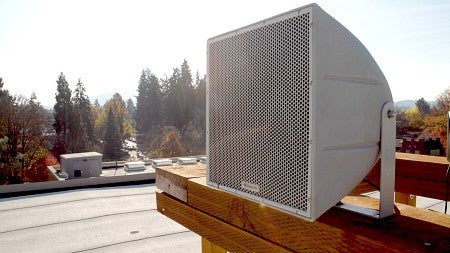If you’re new to the University of Oregon, you may not have heard the daily “chimes” ringing on the quarter hour from speakers mounted atop the Erb Memorial Union. If you’re post-1954 alumni, however, you may have set your watch to it.
The sound comes from a carillon — pronounced KAR-uh-lon — defined as a musical instrument consisting of at least 23 cast bronze, cup-shaped bells, which are played serially to produce a melody or sounded together to play a chord. But technically, the UO has a “carillon system,” which simulates and amplifies bell sounds that are then played from loudspeakers.
Over the past 65 years, the UO has had three different systems for sounding the campus chimes. The most recent upgrade, which took place after a major expansion and renovation of the EMU, brought the carillon up to modern standards, but it still carries a link to the past, thanks to a longtime UO music instructor.

“That never happened,” said Mike Kraiman, technical administrator in campus scheduling. “And although some people thought there were actual bells mounted on the roof, in reality it’s just four loudspeakers connected to a powerful amplifier.”
The original electronic chimes consisted of 25 small rods with amplified tones housed in a large, radio-sized cabinet accompanied by a small keyboard. And for 41 years, students within listening distance of the EMU could hear the familiar chimes every 15 minutes during the day, followed by the Oregon fight song, “Mighty Oregon,” at noon and 6 p.m.
However, the antiquated mechanical technology of the 1954 system was prone to malfunction, which prompted the decision in 1995 to upgrade to an all-electronic unit that uses memory chips and microprocessors to play digitally sampled bell sounds. The system came with a number of preprogrammed songs, but to enhance the repertoire, UO School of Music and Dance organ and harpsichord instructor Barbara Baird was recruited to record five UO songs as well as an extended version of “Pomp and Circumstance” for commencement.
For nearly 20 years more, the bells were a UO staple, chiming on the quarter hour and playing music for special occasions, like commencement, but also for somber remembrances. Several days after 9/11 in 2001 patriotic songs were played through the system, and again in 2007 following the school shooting at Virginia Tech, in which the bells chimed 33 times for the victims during a campus memorial service.
When renovation began on the EMU in 2014, the bells were taken out of service. After a three-year-silence they were reactivated in early 2017 only to have the unit fail a year later, requiring the carillon to be replaced a third time.
Baird, the musician behind the 1995 carillon system, stepped up again to rerecord songs for the new unit, which were played for the first time before the homecoming parade Oct. 25.
But even with her musical training, Baird says playing the carillon is a different beast because, unlike a harpsichord or organ, the sounds have heightened overtones.
“The skill there is that you can’t just read what’s on the page; you have to pick and choose to get the optimum sound. You have to know what to leave out,” she said. “The nail-biter part of it was the making it up as I went along. I could follow the melody with my right hand, but I was kind of improvising with my left hand.”
Ironically, Baird admits she has yet to hear her own recordings.
“The sad thing is that over here in the music school, we don’t hear it,” she said with a laugh. “Even though I recorded it, I’ve never heard it play because I’m never over near the EMU. I guess I better make a point to wander over there now.”
She may have heard the emergency alert though.
The new system can also sound an emergency warning to the community, which many discovered during a test in September. Kraiman said the chimes and music are played at just 55 percent volume, but the emergency alert system was tested 100 percent volume, upsetting some people on campus.
“It was a test weather warning about severe thunderstorms and it just so happened it was on a day when we were having a thunderstorm,” he said. “We’re still working out the kinks.”
Because the EMU is a central gathering place on campus, Kraiman hopes the system may eventually have more interactive uses, such as live music events presented by music students. But for now, the next generation of students will have their chance to experience the noontime chimes, followed by a rousing rendition of the Oregon fight song and, perhaps Barbara Baird will get a chance to hear it too before another 20 years goes by.
“The recently relaunched carillon bells will continue to retain their place as one of the UO’s distinctive aural traditions,” Kraiman said.
—By Sharleen Nelson, University Communications

